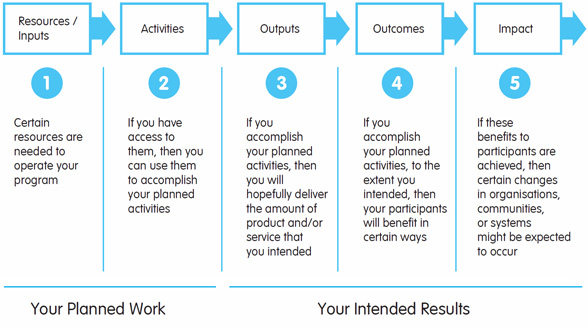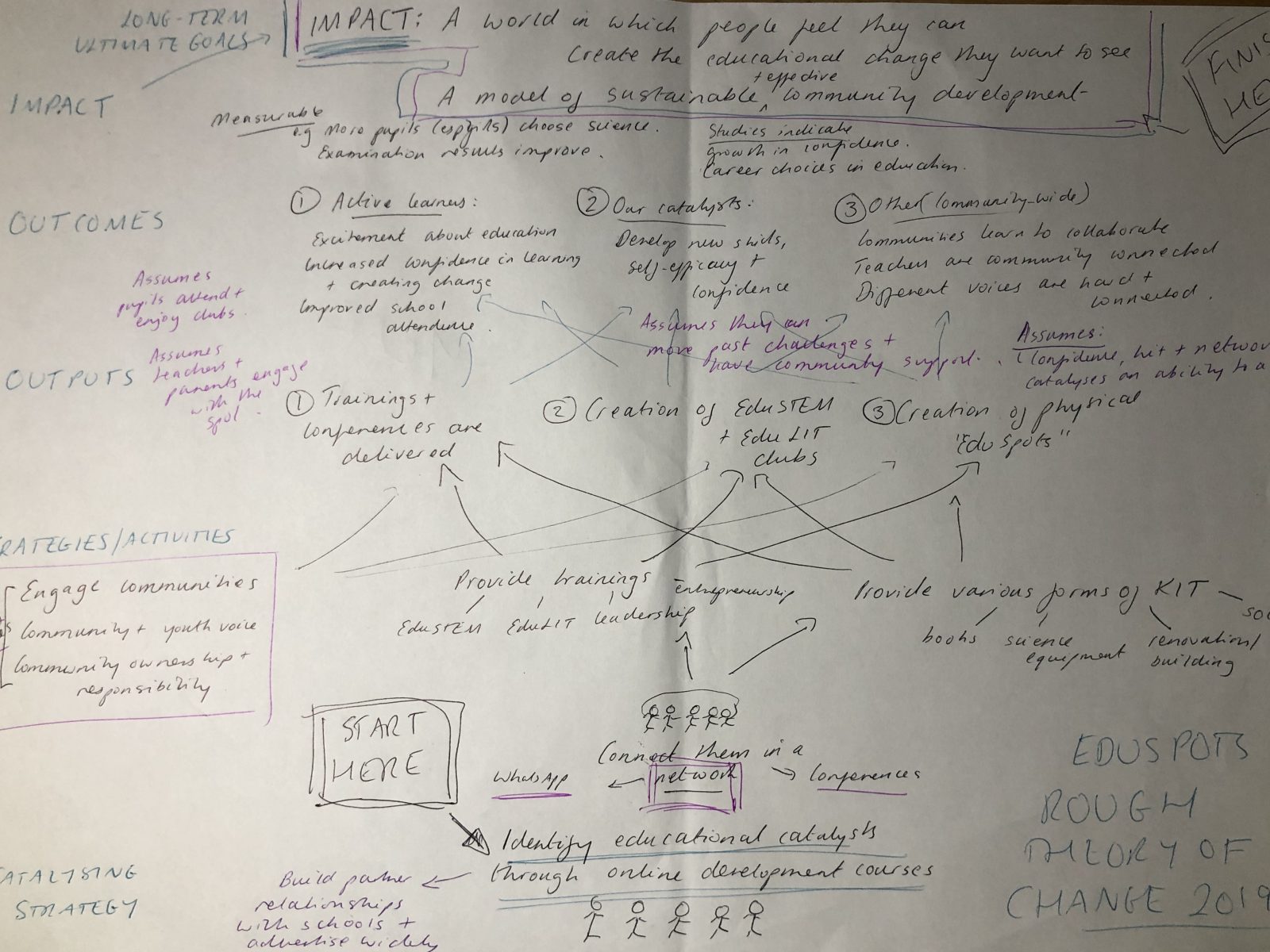What is a theory of change?
A straightforward definition of the term theory of change has been provided by (Weiss, 1972) as ‘why and how an initiative works.’ This theory demonstrates how we envision change to occur as a result of our work, reflecting on the assumptions we are making in this process.
A theory of change is best developed at the start of an initiative and can be shaped by practice. However, it can also be developed after the start of a project mainly to reflect on and evaluate efforts and improve practice. Our agenda for change can be in a visual diagram, writing or video or a combination.
Why do we need a Theory of Change?
The theory can sharpen the planning and implementation of an initiative, facilitate data collection and impact measurement and strengthen our case for attributing impact to our work or otherwise (Connell & Kubisch, 1998). Conceptualising our ToC helps to clarify what should be prioritised and helps us to identify metrics for answering the question ‘what difference am I making?’ (impact measurement to be discussed in detail later on this course). This diagram explains the simple stages of a Theory of Change. You may also want to think about your assumptions and risks in the process (taken from Innovation for Social Change. )

Or an alternative model:
Things to consider when building a theory of change
1. Look at the big picture and connect the dots
There are a few questions we need to be answering when building a ToC. What do we want to achieve (impact) with who and for whom (team and target population)? What does achieving this look like? (results/what will change?) and when do we expect to see this change (timelines)? What is needed for these outcomes to be achieved (mindsets, conditions, policies, investment, skills)? What things can be done (strategies, activities) to address these needs? How can we do this effectively (quality control)? ‘
You also need to think carefully about the assumptions you are making in the process. For example, at the start of EduSpots (then Reading Spots) we assumed that provision of books, in itself, would lead to improved literacy levels, but this simply wasn’t true. If teachers or parents were not available to support, and pupils were not interested in reading or not given access, the books sometimes had no impact at all.
2. Results and timelines
A clearly defined set of goals that we want to achieve is vital. Forti (2012) notes that a theory of change must clarify what results we will hold ourselves accountable for achieving; in other words, what results must we deliver to be successful? If the expected impact of your project is to end littering in an area, we must consider the indicators of improved sanitation. The answers to this become the results we are pursuing. Concretise the measurable results envisioned and project specific data (qualitative and quantitative) to serve as a benchmark to evaluate project activities. Clarifying timelines for both impact and activities also helps planning especially when the project is focused on people.
3. Identify what is needed and build a strategy to fill the gap
With our impact, expected results and timelines in mind, the next thing to think about is what is standing between the results we are seeking and the current situation. In simple terms, we are identifying what contributes to the problem and needs to change to bring the results we envision. Depending on your project, this may centre around developing people’s knowledge, skills and mindsets mainly through education, introducing policies and practices to influence how things are done, providing resources where needed, employing communication and advocacy, building relationships, among others.
The next task in creating your theory of change is to brainstorm and develop a strategy that when operationalised, will bear the fruits we are looking to reap: ‘between dreams and fruition, yawning gaps close’ (Darmani, ‘Scribbler’s Dream’). Envisioning impact, defining results and strategizing how to get them will guide us to be intentional about our activities.
This was EduSpots’ first rough Theory of Change (final version soon to be formalised, and this doesn’t include full detail on impact measurement, outcomes etc ).
Remember that your ToC should first take a scribbled rough form – thinking about the process (and its assumptions) is the most important thing.
This example theory of change is for a youth unemployment project.

E.g from The Girls not Brides Project – this is a complex but clear ToC

What else will help the success of your project?
Project planning
The greatest tool for creating our impact is our project activities, which should be planned and implemented effectively. It becomes crucial then to work with the best people possible and employ quality control measures to get real about the impact we are creating or ‘signing up to create, not just what we hope will happen’ (Forti, 2012).
Solicit and sustain local support
The involvement of the target population allows us to share our dreams with the people for whom we are ‘dreaming’ and get them to dream collectively. An intervention is more likely to realise its objectives if it is fully embraced by the target population. It has been suggested that co-creating interventions with stakeholders with a deeper knowledge of the systems one seek to alter allow communities to own the change process (Moore & Evans, 2017) – you may want to involve local people in the very creation of the Theory of Change. This may help the team, stakeholders and beneficiaries to not see us as ‘the solution’ or ‘provider’ but as a catalyst working with them for results. Eroding the external look of the project deepens commitment to the initiative, decreases dependence and clarifies expectations. It also increases the skills and confidence of people and ensures sustained efforts in managing and safeguarding the intervention.
What windows of opportunity can we capitalize on?
It goes without saying that as changemakers we need to invest in building our knowledge and capacity as well. Speak to people, attend relevant training and conferences, take courses (yes we are doing this!), seek mentoring, read books and learn from other projects. In recent times, information and communication technology is speeding the global flow of information and creating a library of world knowledges (Spring, 2009).
Conclusion
In short, the ToC clarifies what one seeks to achieve, how one seeks to achieve it, what happens when it is achieved, and how those achievements will without deviation address the needs identified. Like many other organisations, EduSpots is currently reviewing our theory of change following our transition from Reading Spots, evidencing that groups and organisations need to constantly review and improve their theories and practices.
This video from Social Investment Business offers a simple explanation of the process involved in building a theory of change:
Tasks
Task 1:
EITHER: In your opinion, what do you think will be the most challenging thing to do (if any) concerning the ideas shared above?
OR: Briefly describe the Theory of Change of your own organisation, project, or an organisation you work for or know.
Task 2: Try to respond to another person’s response to task 1, attempting to offer support, agree or offer an alternative view.
Works Cited
Brennan R, Valentine D and Willis H. (2016). How to Build a Theory of Change. Know How. [Online] The National Council for Voluntary Organisations, December 7, 2016. [Cited: 02 04, 2019.] https://knowhow.ncvo.org.uk/how-to/how-to-build-a-theory-of-change/@@historyview.
Connell, J., & Kubisch, A. (1998). Applying a Theory of Change Approach to the Evaluation of Comprehensive Community Initiatives: Progress, Prospects, and Problems. Washington: The Aspen Institute.
Forti, Matthew. 2012. Six Theory of Change Pitfalls to Avoid. Stanford Social Innovation Review. [Online] Standford University, May 23, 2012. [Cited: February 3, 2020.] https://ssir.org/articles/entry/six_theory_of_change_pitfalls_to_avoid#.
Moore, G. F., & Evans, R. E. (2017). What theory, for whom and in which context? Reflections on the application of theory in the development and evaluation of complex population health. SSM – Population Health, 132.
Spring, J. (2009). Globalization of Education: An Introduction. New York: Routledge.
Weiss, C. H. (1972). Evaluation Research: Methods of Assessing Program Effectiveness. Englewood Cliffs: NJ: Prentice-Hall.



